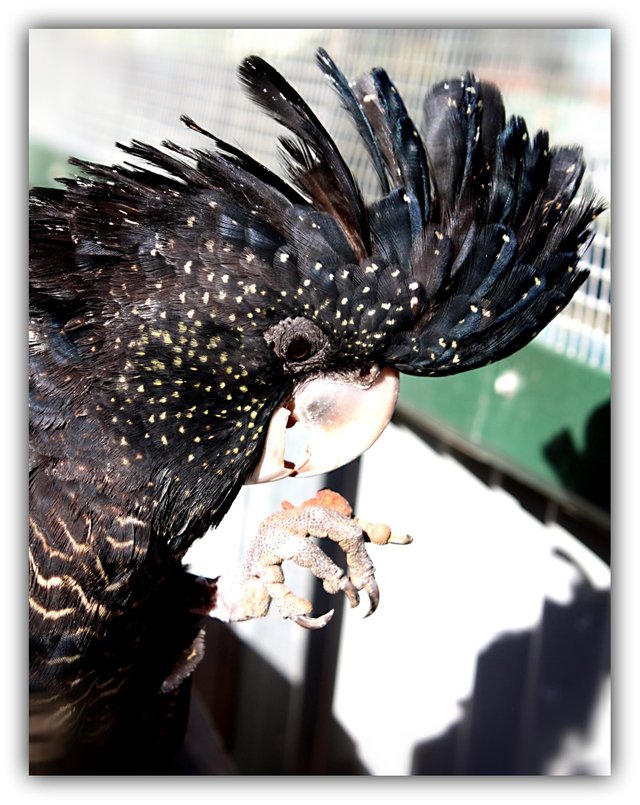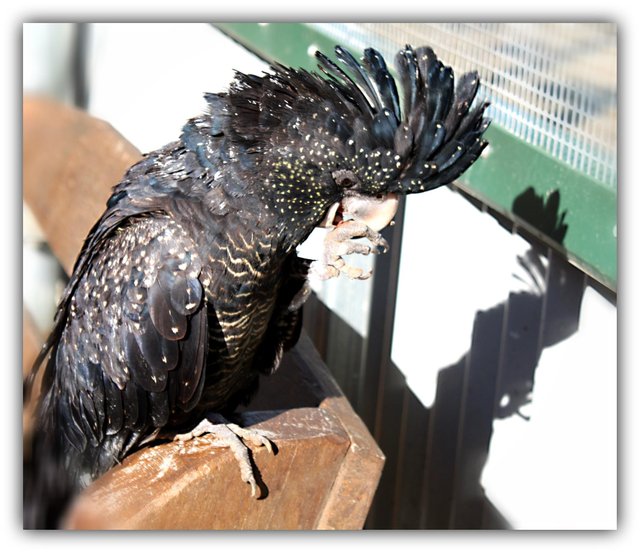'Red Tailed Black Cockatoo.'
This is my entry for this weeks 'Feathered Friday,' hosted by @melinda010100
Red-tailed black cockatoo (Calyptorhynchus banksii) are large cockatoos and are native to Australia. They are also known as Banksian- or Banks' Black Cockatoos. Mature Males have bright red panels on their tails and it this characteristic that gives this species its name. They are found in the drier parts of Australia but are more widely distributed in the northern areas. There are five subspecies and are recognized by the size of their beaks. Two of these species are threatened and they are the forest red-tailed black cockatoos and south-eastern red-tailed black cockatoos. This situation is due largely to deforestation and other changes to their habitat.
Red-tailed black cockatoos are commonly found in eucalyptus woodlands, and along water courses. In the north, these birds congregate in large flocks. Their diet consists mainly of seeds. They measure approximately 24 inches in length and are sexually dimorphic. The male’s are predominantly black and they have a black crest of elongated feathers from the forehead and crown. Their bills are grey and their black tails are adorned two lateral bright red panels. The females are black but have yellow-orange stripes in their tails and chest and also have yellow grading to red spots on their cheeks and wings. Their bills are paler in colour than the males.

Red-tailed black cockatoos share other common cockatoo and parrot characteristics such as having zygodactyl feet with two toes facing forward and two facing backward. This allows them to grasp objects with one foot whilst standing on the other. As with a number of parrots, the Red-tailed black cockatoos are exclusively left-footed.
In northern and central Australia, birds may feed on the ground, while the two southern subspecies, graptogyne and naso, are almost exclusively arboreal.[50] They tend to fly rather slowly with intermittent deep flapping wingbeats, markedly different from the shallow wingbeats of the similar glossy black cockatoo. They also often fly at considerable height.
The male red-tailed black cockatoo courts by puffing up crest and cheek feathers, and hiding the beak; it then sings and struts, ending in a jump and a flash of red tail feathers toward the female who will most often reply by defensively biting him.[51] Breeding generally takes place from May to September except in the case of the South-eastern subspecies, which nests during summer (December to February). Pairs of the subspecies samueli in the Wheatbelt region of Western Australia may produce two broods,[37] while those of South-eastern subspecies only produce one.[52] Nesting takes place in large vertical tree hollows of tall trees.
Isolated trees are generally chosen, so birds can fly to and from them relatively unhindered. The same tree may be used for many years. Hollows can be 1 to 2 metres (3–7 ft) deep and 0.25–0.5 metres (10–20 in) wide, with a base of woodchips. A clutch consists of 1 to 2 white, lustreless eggs, although the second chick is in most cases neglected and perishes in infancy.

These birds can live a very long time in captivity with one cockatoo from the Taronga Zoo in Sydney reportedly living over fifty years.
Raucous and noisy, these birds are often spotted flying high overhead in small flocks, and will also join in flight with other cockatoos. Flocks of up to 500 birds can be seen in the north especially when focused on a particular food source. But apart from that, they are usually shy around humans.
Source:

THANK YOU FOR VIEWING. HAVE A GREAT DAY.







thank you @pixresteemer.
I like these birds, interesting to be shy...
Thanks @bluemoon I think it is unusual for Australian birds to be shy as they are generally bold and gregarious. Thanks so much for visiting and lending your support. Much appreciated my friend. 💐
With pleasure! It makes me very happy when I meet with your posts.
Very interesting! Never seen a black one before. A friend used to keep a big white one as a pet!
Posted using Partiko iOS
Thanks for your comments. Much appreciated.
What an interesting bird! I did not know that about their feet. Left-footed! Great photos and you even got a shadow there! Thanks so much for supporting #featheredfriday.
I learned a thing or two myself when I did my research. A pity I didn't get a photo of his tail.
Nice hairdo! The "ring" around their eyes is really interesting. Are those made of down?
Sorry I can't answer your question. It was the first time I had come across this bird myself.Thanks for your visit.
Howdy Trudee! What an interesting bird! I like those practical feet too. And those are really good pictures you got!
It was the first time I'd seen one of these birds myself. Would loved to had seen him in flight to see what his tail looked like. He seemed like he was deep in thought in these photos.
Howdy today Trudee! yes he did didn't he? He was probably wondering when dinner was getting there!